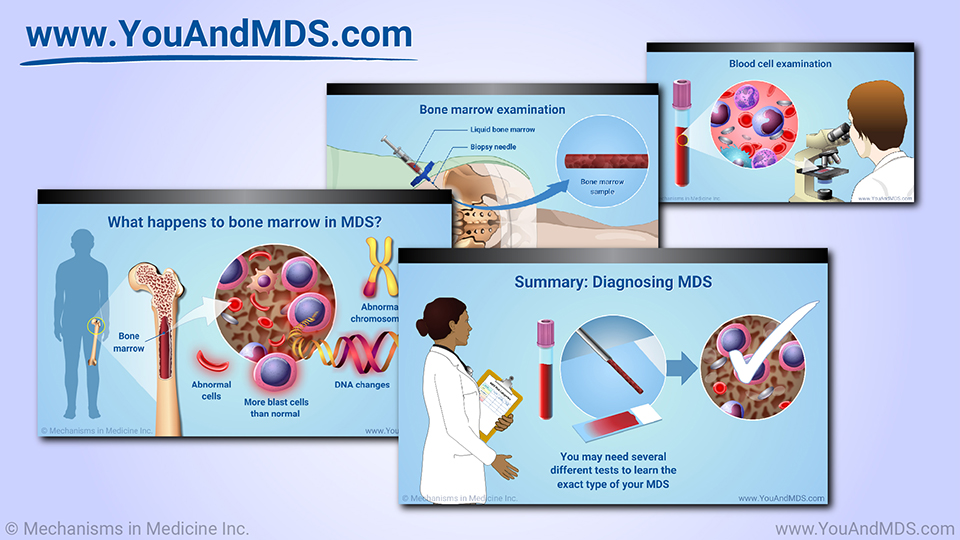Slide Show - Diagnosis of MDS
Click here to take our SURVEY
Your feedback is important to us! We will use your feedback to develop future areas of content about MDS which will help other patients, caregivers and families.









*Please note: This slide show represents a visual interpretation and is not intended to provide, nor substitute as, medical and/or clinical advice.
How is MDS diagnosed?
MDS is diagnosed by laboratory testing, which includes blood cell counts, blood cell examination, and bone marrow tests.
Complete blood count
Your doctor might find MDS if you have low numbers of certain blood cells on a test called a “complete blood count.” This test is commonly done as part of your annual physical examination or general wellness check. Or your doctor might do this test if you are not feeling well.
Low blood count: Cytopenia
A complete blood count measures your levels of red and white blood cells and platelets. When you have too few of some or all of these, doctors call it “cytopenia,” or a “low blood count”.
Symptoms related to low red blood cells
Having too few healthy, mature red blood cells is called “anemia". You might feel tired – from just being a little tired, to feeling completely exhausted. Other symptoms include being pale and having shortness of breath.
Symptoms related to low white blood cells
Having too few normal, mature white blood cells is called “neutropenia". You might get infections and fevers more easily when your white cell count is low.
Symptoms related to low platelets
Platelets are the cells that help your blood clot normally. If you don’t have enough healthy platelets, you might bruise and bleed easily, or have frequent nosebleeds or bleeding gums.
A low platelet count is called “thrombocytopenia".Blood cell examination
Besides a complete blood count, the laboratory doing the test will look at a sample of blood cells under a microscope. They do this to learn how many normal and abnormal cells are present, which types are abnormal, their shape, and how they look.
This information tells your doctor what type of MDS you have.
Bone marrow tests
If your blood tests show low blood counts, your doctor may recommend that you have a bone marrow examination.
This involves taking a small sample of liquid bone marrow and bone from your hip with a needle. You will have some anesthesia to make you feel more comfortable. A doctor called a pathologist will look at the sample for abnormal cells and DNA changes.
What happens to bone marrow in MDS?
If you have MDS, your bone marrow will show DNA changes, more immature stem cells, or blast cells, than normal, and abnormal cells. Some people with MDS have specific DNA changes, such as abnormal chromosomes or mutations.
Is there a screening test for MDS?
There is no standard screening test for MDS, like a mammogram to check for breast cancer or a colonoscopy for colon cancer.
But if you are at high risk because of past cancer treatment, working with chemicals, or other risk factors, you might need a complete blood count each year.
Talk to your doctor about your risk for MDS
MDS is not contagious and is rarely inherited. However, knowing what type of work you do or used to do, whether you ever had chemotherapy or radiation treatment, and if you lived near a source of chemicals or radiation is important information for your doctor.
What are MDS overlap syndromes?
You should also know about a group of disorders called MDS overlap syndromes. Another name for these bone marrow disorders is MDS-MPN.
These disorders are similar to MDS where some of these disorders have low blood counts, especially low counts of red cells. But in overlap syndromes, white cell or platelet counts may be high.
What are MDS overlap syndromes?
The overlap syndromes that doctors know about now are chronic myelomonocytic leukemia, or CMML; atypical chronic myelogenous leukemia, or aCML; juvenile myelomonocytic leukemia, or JMML; and a disorder that doctors call unclassifiable, or MDS/MPN-U.
How is MDS classified? WHO classification system
The World Health Organization breaks MDS into several types based on the bone marrow exam, blast count, and DNA changes. These classifications can be important for knowing how your MDS may progress.
How is MDS classified? Revised International Prognosis Scoring System
The International Prognosis Scoring System, or IPSS, is another way to classify MDS. A revised version from 2012 is called the IPSS-R.
It gives you a score based on the number of blasts in your bone marrow, what types of abnormalities are present, and what genetic changes you have.
How is MDS classified? Revised International Prognosis Scoring System
The scores match up with risk categories from very low and low to intermediate, high, and very high. Your score tells you about your risks of MDS changing to acute leukemia and your outlook for survival.
Summary: Diagnosing MDS
Diagnosing MDS is not always easy. You may need several different tests to learn the exact type, how severe it is, or whether you have another disorder, such as an overlap syndrome or other blood cancer. But the information your doctor gathers will help determine the best treatment. This will help you live as well as possible even if you are diagnosed with MDS.
Click here to take our SURVEY
Your feedback is important to us! We will use your feedback to develop future areas of content about MDS which will help other patients, caregivers and families.









This educational activity has been developed by the Myelodysplastic Syndromes Foundation, Inc. and Mechanisms in Medicine Inc.
This activity is supported by educational grants from Bristol-Myers Squibb, Geron, and Taiho.
This website is part of the Animated Patient™ series developed by Mechanisms in Medicine Inc., to provide highly visual formats of learning for patients to improve their understanding, make informed decisions, and partner with their healthcare professionals for optimal outcomes.

